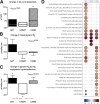Saturated Fat Is More Metabolically Harmful for the Human Liver Than Unsaturated Fat or Simple Sugars
- PMID: 29844096
- PMCID: PMC7082640
- DOI: 10.2337/dc18-0071
Saturated Fat Is More Metabolically Harmful for the Human Liver Than Unsaturated Fat or Simple Sugars
Abstract
Objective: Nonalcoholic fatty liver disease (i.e., increased intrahepatic triglyceride [IHTG] content), predisposes to type 2 diabetes and cardiovascular disease. Adipose tissue lipolysis and hepatic de novo lipogenesis (DNL) are the main pathways contributing to IHTG. We hypothesized that dietary macronutrient composition influences the pathways, mediators, and magnitude of weight gain-induced changes in IHTG.
Research design and methods: We overfed 38 overweight subjects (age 48 ± 2 years, BMI 31 ± 1 kg/m2, liver fat 4.7 ± 0.9%) 1,000 extra kcal/day of saturated (SAT) or unsaturated (UNSAT) fat or simple sugars (CARB) for 3 weeks. We measured IHTG (1H-MRS), pathways contributing to IHTG (lipolysis ([2H5]glycerol) and DNL (2H2O) basally and during euglycemic hyperinsulinemia), insulin resistance, endotoxemia, plasma ceramides, and adipose tissue gene expression at 0 and 3 weeks.
Results: Overfeeding SAT increased IHTG more (+55%) than UNSAT (+15%, P < 0.05). CARB increased IHTG (+33%) by stimulating DNL (+98%). SAT significantly increased while UNSAT decreased lipolysis. SAT induced insulin resistance and endotoxemia and significantly increased multiple plasma ceramides. The diets had distinct effects on adipose tissue gene expression.
Conclusions: Macronutrient composition of excess energy influences pathways of IHTG: CARB increases DNL, while SAT increases and UNSAT decreases lipolysis. SAT induced the greatest increase in IHTG, insulin resistance, and harmful ceramides. Decreased intakes of SAT could be beneficial in reducing IHTG and the associated risk of diabetes.
Trial registration: ClinicalTrials.gov NCT02133144.
© 2018 by the American Diabetes Association.
Figures



References
-
- Yki-Järvinen H. Non-alcoholic fatty liver disease as a cause and a consequence of metabolic syndrome. Lancet Diabetes Endocrinol 2014;2:901–910 - PubMed
-
- Rosqvist F, Iggman D, Kullberg J, et al. . Overfeeding polyunsaturated and saturated fat causes distinct effects on liver and visceral fat accumulation in humans. Diabetes 2014;63:2356–2368 - PubMed
-
- Sevastianova K, Santos A, Kotronen A, et al. . Effect of short-term carbohydrate overfeeding and long-term weight loss on liver fat in overweight humans. Am J Clin Nutr 2012;96:727–734 - PubMed
Publication types
MeSH terms
Substances
Associated data
Grants and funding
LinkOut - more resources
Full Text Sources
Other Literature Sources
Medical
Research Materials

